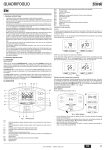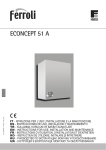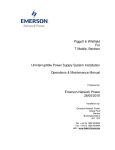Download 600-2704 User`s Manual
Transcript
600-2704 PCI EXPRESS EXPANSION SYSTEM USER’S MANUAL The information in this document has been carefully checked and is believed to be entirely reliable. However, no responsibility is assumed for inaccuracies. Furthermore, Cyclone Microsystems, Inc. reserves the right to make changes to any products herein to improve reliability, function, or design. Cyclone Microsystems, Inc. neither assumes any liability arising out of the application or use of any product or circuit described herein, nor does it convey any license under its right or the rights of others. Revision 1.1, November 2007 Cyclone P/N 800-2704 Copyright 2007 by Cyclone Microsystems, Inc. CONTENTS CHAPTER 1 1.1 INTRODUCTION ..............................................................................................................................1-1 1.2 SPECIFICATIONS............................................................................................................................1-3 1.3 STANDARDS ...................................................................................................................................1-3 CHAPTER 2 2.1 THEORY OF OPERATION ..............................................................................................................2-1 CHAPTER 3 3.1 600-2704 CHASSIS..........................................................................................................................3-1 3.2 POWER CONSIDERATIONS...........................................................................................................3-1 CHAPTER 4 4.1 SYSTEM POWER UP ......................................................................................................................4-1 4.2 SEATING OF CARDS ......................................................................................................................4-1 4.3 LINK INDICATION - LED DEFINITION PCIe-408 ............................................................................4-1 4.4 LINK INDICATION - LED DEFINITION PCIe-404 ............................................................................4-2 CHAPTER 5 5.1 PHYSICAL CONFIGURATION.........................................................................................................5-1 CHAPTER 6 6.1 i REFERENCE MANUALS .................................................................................................................6-1 600-2704 PCI Express Expansion System User’s Manual Revision 1.1, November 2007 CONTENTS LIST OF FIGURES Figure 1-1. 600-2704 Block Diagram .....................................................................................................1-1 Figure 5-1. PCIe-414 Physical Configuration.........................................................................................5-1 Figure 5-2 PCIe-408 Physical Configuration.........................................................................................5-2 Figure 5-3 600-2704 Chassis Drawing .................................................................................................5-3 Figure 5-6 600-2704 Chassis................................................................................................................5-3 LIST OF TABLES Table 1-1. Table 3-1. Table 3-2 Table 3-3 ii Specifications ......................................................................................................................1-3 PCIe-414 Power Requirements...........................................................................................3-1 PCIe-408 Power Requirements...........................................................................................3-1 Power Supplied Per PCIe Slot.............................................................................................3-1 600-2704 PCI Express Expansion System User’s Manual Revision 1.1, November 2007 CHAPTER 1 INTRODUCTION 1.1 INTRODUCTION The Cyclone Microsystems’ 2704 PCI Express Expansion System is a PCI Express (PCIe) expansion system that allows the user to add up to seven PCI Express add-in cards. Most PCs contain few PCI Express slots making them poorly suited for embedded systems requiring a wealth of different I/O boards and co-processor resources. The 2704 PCI Express Expansion Systems permits system developers to use powerful and costeffective PCs as a foundation for a robust embedded system. The seven PCI Express slots are organized as three x8 slots and four x4 slots. All expansion slots accommodate full length and full height cards and are cooled by one 120 CFM and two 59 CFM fans. A 650 watt supply powers the rack mounted expansion chassis. The Expansion System supports 20 Gb/s bi-directional traffic to and from the host system and utilizes non-blocking PCI Express switches for excellent peer-to-peer I/O bandwidth. For PCs with modern BIOSs, the 2704 Expansion System is recognized by the host system upon boot-up, requires no hardware specific drivers, and is entirely host operating system agnostic. The 600-2704 system is composed from three elements: a PCI Express Host Bus Cable Adapter, an Expansion System Cable and an Expansion Chassis. Our PCIe-408 Host Cable Bus Cable Adapter card is inserted into a host computer’s PCIe slot. PCIe expansion cable links the PCI host with the expansion chassis. The expansion chassis is populated with the PCIe-414 Switched Backplane. PCI Express is a high performance, general purpose I/O inter-connect defined for a wide variety of computing and communication platforms. Key PCI attributes, such as its usage model, load-store architecture, and software interfaces are maintained, whereas its parallel bus implementation is replaced by a serial interface. PCI Express take advantage of recent advances in point-to-point inter-connects, Switchbased technology, and packetized protocol to deliver new levels of performance. 600-2704 PCI Express Expansion System User’s Manual Revision 1.1, November 2007 1-1 INTRODUCTION PCIe-408 PCI-E 401 x8 Bridge PCI-to-PCI Bridge Link Host PCI Express System PCI-Express x8 64-bit CompactPCI Bus x8 PCI ExpressCable PCIe-414 Expansion System PCI-Express x8 Cable Interface PCI-Express x8 Slot x8 PCI-Express x8 Slot x8 PCI-Express x8 Slot x8 PCI-Express x8 Slot x4 PCI-Express x8 Slot x4 PCI-Express x8 Slot PCI-Express x8 Slot PCI-Express Switch x4 x4 Figure 1-1. 600-2704 Block Diagram 1-2 600-2704 PCI Express Expansion System User’s Manual Revision 1.1, November 2007 INTRODUCTION 1.2 SPECIFICATIONS The specifications in table 1-1detail the 600-2704 Expansion System chassis including the PCIe-414 expansion backplane and the 450W power supply. The chassis also includes one 120 CFM and two 59 CFM fans. Table 1-1. Specifications Physical Electrical Environmental 1.3 Height 7 inches Width 17 inches Depth 22 inches Other 19 inch rack mountable Voltage 115/230 VAC switch select Frequency 60Hz/50Hz. Input Current 9.0 A for 115 CVAC, 5.0 A for 230 VAC. Inrush Current 60 A max. for 115 VAC Operating Temperature 0 to 50 Degrees Celsius Relative Humidity 0% to 95% (non-condensing) Storage Temperature -20 to 70 Degrees Celsius STANDARDS PCI Express Base Specification Revision 1.1 PCI Express Card Electro Mechanical Specification 1.1 PCI Express External Cabling Specification 1.0 600-2704 PCI Express Expansion System User’s Manual Revision 1.1, November 2007 1-3 CHAPTER 2 THEORY OF OPERATION 2.1 THEORY OF OPERATION The basic PCI Express Link consists of dual unidirectional differential links, implemented as a transmit pair and a receive pair. The signaling rate for PCI Express is 2.5 Gigabits/second/Lane/direction. A link supports at least one Lane. The PCI Express link from the PCIe-408 over the cable to the PCIe-414 is an eight lane (x8) link. The PCIe-414 provides three x8 slots and four four lane (x4) slots. Each slot can accommodate either single lane (x1), x4 or x8 add-in cards. In the case where a x8 add-in card is installed into a x4 slot, only the first four lanes on the add-in card will be utilized. This situation is termed “down-shifting”. Per the PCI Express Specification, down-shifting is only allowed in this case. All slot connectors on the PCIe-414 are mechanically x8 with the x4 slots leaving the upper four lanes not connected. Up-plugging, i.e., plugging a smaller link card into a larger link connector, is fully allowed. Once the PCIe-408 is installed into the host PC, the cable connected to the PCIe-414, the chassis plugged into an AC power outlet and any desired add-in cards are installed, the system is ready to be turned on. A number of things happen at this point. First, the PCI Express links are initialized. This is a purely hardware initialization where each PCI Express link is set up following a negotiation of lane widths by the two ends of each link. No firmware or operating system software is involved. Once the links are initialized or “trained”, there are LED indicators on each of the Cyclone Microsystems’ cards that indicate both the links that are trained and the individual lanes. A detailed explanation of the LEDs follows later in this manual. One essential requirement for system initialization is the ability of the Host system’s BIOS to be able to enumerate the many bridges inherent in a complex PCI Express design. The links from the PCIe-408 to the PCIe-414 are created with PCI Express Switches. Each link looks like a PCI-to-PCI bridge to the Host’s BIOS. The number of bridges can add up quickly. Older BIOS may not have the ability to handle the number of bridges. Make sure that the BIOS on the host computer has the latest updated BIOS. If required, contact the host system’s manufacturer to make sure that the BIOS used can handle the large number of bridges that it will see in the system. 600-2704 PCI Express Expansion System User’s Manual Revision 1.1, November 2007 2-1 CHAPTER 3 EXPANSION SYSTEM OPERATION 3.1 600-2704 CHASSIS The PCIe-414 is installed into a seven slot rack mountable chassis. The chassis provides access to three x8 PCI Express slots and four x4 PCI Express slots. All slots can accommodate standard height and full length PCI Express add-in cards. The chassis also contains three drive bays that may be used by the user to install peripheral devices for their particular application. There are several ATX four pin peripheral power connectors available from the power supply. The chassis contains a 650W power supply. Tables 3-1 through 3-3 show the power consumption for the Cyclone Microsystems boards and the power supplied to the PCI Express slots. Note that the PCIe-408 is installed in and powered by the host supply. Consequently, the PCIe-408 should not be included as a component of the Expansion Chassis power budget. In a fully populated system, with each PCI Express add-in card drawing 25W, there is an additional 70W of +5V and 100W of +12V available for use via the peripheral power connectors. 3.2 POWER CONSIDERATIONS Table 3-1. PCIe- 414 Power Requirements Voltage Current Typical Current Maximum +3.3V 0.33 Amps 0.40 Amps +5V 1.03 Amps 1.56 Amps +12V 0.02 Amps 0.04 Amps Table 3-2. PCIe- 408 Power Requirements Voltage Current Typical Current Maximum +3.3V 0.32 Amps 0.37 Amps +12V 0.25 Amps 0.35 Amps Table 3-3. Power Supplied Per PCIe Slot Voltage Current Maximum Voltage Tolerance +3.3V 3.0 Amps +/- 9% +12V 2.1 Amps +/- 8% * Required by the PCI Express Card Electromechanical Specification Revision 1.0a. Note that the total power for each PCIe shall not exceed 25W. Airflow in the 600-2704 chassis is provided by one 120 CFM located at the front of the chassis and two 59 CFM fans located at the rear of the chassis. 600-2704 PCI Express Expansion System User’s Manual Revision 1.1, November 2007 3-1 CHAPTER 4 SYSTEM POWER UP 4.1 SYSTEM POWER UP The host PC with the PCIe-408 installed controls power-up for the entire system. The PCI Express cable should be connected between the PCIe-408 and the PCIe-414 and the 600-2704 power cord should be connected to the chassis and plugged in to a power socket. There is a power button on the front of the 600-2704 Expansion Chassis, however, it is not connected and serves no practical purpose in this application. When the host PC is powered on, a signal is sent over the PCI Express cable to turn on the 6002704. If the chassis does not power up, make sure that all cards are seated properly, the chassis is plugged in and the PCI Express cable is connected properly. There is only one LED on the front of the expansion chassis that has meaning. The green LED indicates that the chassis is powered. 4.2 SEATING OF CARDS Unlike standard PC applications, the 2704 Expansion Systems has a narrow lower gate that precisely engages the lower end of the PCI Express Add-In board’s face panel. The purpose is to insure correct electrical connectoring mating of up-plugged boards. Failure to accurately mate the lower end of the face panel with the chassis, lower gate will lead to the board not being recognized by the host. 4.3 LINK INDICATION - LED DEFINITION PCIE-408 There are many LED indicators on both of the printed circuit boards (PCBs) that indicate the status of all links and individual lanes. These are pictured Figure 5-2. The PCIe-408 has two banks of eight LEDs. These LEDs are located on the top side or component side of the PCB. Each LED corresponds to one lane of that particular link. One bank is labeled “UP LN 0” (upstream) and the other bank is labeled “DWN LN 0” (downstream). The eight upstream LEDs give the state of the link from the PC host that the PCIe-408 is installed into to the PCIe-408. If the PCIe-408 is installed into a x8 of x16 slot, then all eight of the upstream LEDs should be on. Since the PCIe-408 upstream port is an x8 link, only eight lanes of a x16 slot will be used. If less than the eight LEDs are on, there is a problem with the link between the PC host and the PCIe408. If the PCIe-408 is installed into a x4 PCIe slot (down-shifting), then only the first four LEDs will be on and the link is trained at x4. If none of the upstream LEDs are on, turn off the host PC and make sure that the PCIe-408 is properly seated into the PCIe connector. The eight downstream LEDs indicate the status of the link connecting the PCIe-408 to the PCIe-414 via the PCI Express cable. If the PCIe-408 is installed into an x8 or a x16 slot and the eight upstream LEDs are on, the PCIe-408 is connected via the PCIe cable to the PCIe-414, all eight of the downstream LEDs should be on. If the PCIe-408 is installed into a x4 slot, there still should be all eight downstream LEDs on. If less than eight LEDs are on, check to make sure that the cable is properly connected to each board. 600-2704 PCI Express Expansion System User’s Manual Revision 1.1, November 2007 4-1 SYSTEM POWER UP 4.4 LINK INDICATION - LED DEFINITION PCIE-414 The PCIe-414 has eight surface mount LEDs located on the top side of the PCB see Figure 5-1. There is one LED for each slot and one LED for the cable link. The LEDs are labeled SLOT A through SLOT G and UP PORT. The UP PORT LED corresponds to the cable link to the PCIe-408. If the LED is on, the Physical Layer of the link for the associated port has trained to at least x1 width. The two LEDs that are seen through the back panel next to the PCI Express connector, CR1 and CR2, also indicate that at least a x1 link between the PCIe-414 and the PCIe-408 has trained at least x1. CR1 and CR2 have identical functions. 4-2 600-2704 PCI Express Expansion System User’s Manual Revision 1.1, November 2007 CHAPTER 5 PHYSICAL CONFIGURATION 5.1 PHYSICAL CONFIGURATION Figure 5-1. PCIe-414 Physical Configuration Figure 5-1 is a physical diagram (not to scale) of the PCIe-414 adapter, showing the location designators of jumpers, connectors, and major ICs. Refer to this figure when component locations are referenced in the manual text. 600-2704 PCI Express Expansion System User’s Manual Revision 1.1, November 2007 5-1 PHYSICAL CONFIGURATION DWN_LN7 DWN_LNO UP_LN0 UP_LN7 Figure 5-2. PCIe-408 Physical Configuration 5-2 600-2704 PCI Express Expansion System User’s Manual Revision 1.1, November 2007 PHYSICAL CONFIGURATION Figure 5-3. 600-2704 Chassis Drawing Figure 5-4. 600-2704 Chassis 600-2704 PCI Express Expansion System User’s Manual Revision 1.1 November 2007 5-3 CHAPTER 6 REFERENCE 6.1 REFERENCE MANUALS PEX 8548 Versatile PCI Express Switch Data Book Version 0.95 PLX Technology, Inc. Sunnyvale, CA (800) 759-3735 www.plxtech.com PCI Express Base Specification Revision 1.0a PCI Express Card Electromechanical Specification Revision 1.0a PCI Express External Cabling Specification Revision 0.7 PCI Local Bus Specification Revision 2.2 PCI-X Addendum Revision 1.0 PCI Special Interest Group (PCISIG) 5440 SW Westgate Dr., #217 Portland OR 97221 (503) 291-2569 (503) 297-1090 (Fax) www.pcisig.org System Host Board PCI Express Specification PICMG 1.3 Revision 1.0 PCI Industrial Computer Manufacturers Group (PICMG) 5401 Edgewater Place, #600 Wakefield MA 01880 (781) 246-9318 (781) 224-1239 (Fax) www.picmg.org 600-2704 PCI Express Expansion System User’s Manual Revision 1.1, November 2007 6-1
































